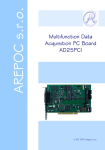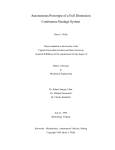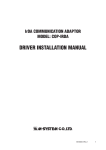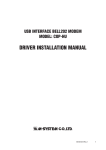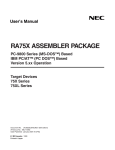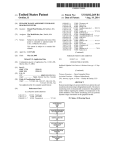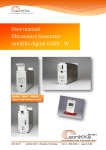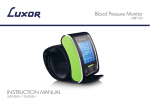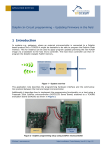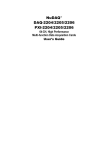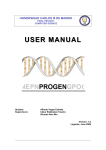Download Multifunction Data Acquisition PC Board AD25HAL
Transcript
M ul t i f unct i on Da t a Acqui s i t i on P C B oa r d AD2 5 H AL © IX. 2003 Arepoc Ltd. Multifunction DAQ Board AD25HAL AREPOC Ltd. Company would like to thank you for purchasing the Multifunction Data Acquisition PC Board AD25HAL. We believe it will meet your expectations. In case you need any assistance, please do not hesitate to contact us: Address: AREPOC Ltd. ILJUSINOVA 4 851 01 BRATISLAVA SLOVAKIA Phone/Fax: E-mail: +421 2 6382 4613 [email protected] Product No.: 2 M ULTIFUNCTION DAQ B O A R D AD25HAL The AD25HAL Analog and Digital I/O Board is specially designed for applications that need a programmable DC current source and precise differential analog inputs. The board is also ideal for highresolution measurement of the magnetic field using our Hall probes. System Requirements The following are the system requirements for installing the card and accompanying DOS software. • An 80486 computer or higher (Pentium class recommended) with a free ISA slot • 1 MB of hard disk space for software installation • 4 MB RAM • DOS 5.0 or higher operating system • WIN 95/98/NT/2000 operating system for DLL library (optional) Unpacking Electrostatic discharge can damage several components on the board. To avoid such damage in handling the board, take the following precautions: • Ground yourself via a grounding strap or by holding a grounded object. • Touch the antistatic package to a metal part of your computer chassis before removing the board from the package. • Remove the board from the package and inspect the board for loose components or any other sign of damage. Notify AREPOC Ltd., if the board appears damaged in any way. Do not install a damaged board into your computer. • Never touch the exposed pins of connectors. Place the board in front of you as you go through the next chapter. This will help you to identify the various components on the board. 3 M ULTIFUNCTION DAQ B O A R D AD25HAL Functional Description The conception of this high performance ISA-bus analog and digital I/O board differs from other data acquisition boards and approaches rather higher accuracy multimeters. Major component of this multifunction plug-in board consists of a single-chip microcomputer, which controls all functions of the board. The board consists of an isolated high resolution integrating AD converter with 8 differential inputs, programmable non-isolated current source and digital inputs/outputs. Board configuration The AD25HAL board contains 3 jumpers and one DIP switch to configure the interface and I/O settings. The DIP switch is for setting the base I/O address. Jumper J1 is for the unipolar or bipolar analog inputs selection. Jumpers J2 and J3 are for +15V and –15V output voltage selection. Fig. 1. The DIP switch, J1 - J3 jumpers and connectors locations. 4 M ULTIFUNCTION DAQ B O A R D AD25HAL Base I/O Address The board is configured at the factory to 784 (310h) base I/O address. These settings are suitable for the most of computers. If your PC has other hardware on this base I/O address installed, you will need to change these settings on this hardware or on the AD25HAL board. Each switch of the DIP switch corresponds to one of the address lines A9 through A2. The board occupies 4 consecutive addresses. Note: If you have changed the AD25HAL base I/O address, you must make a corresponding change to any software you use with the board. The ON selection on the DIP switch means the log. 0. Base address values 000h trough 0FF are reserved for system use. ON 1 2 3 4 5 6 7 8 A2 ……… A9 Fig. 2. The DIP switch default settings (hex 310) Table 1 lists the example of switch settings, the corresponding base I/O address and the base I/O address space for each setting. DIP Switch Settings A9 A8 A7 A6 A5 A4 A3 A2 1 0 0 0 1 0 0 0 1 1 0 0 0 0 0 0 1 1 0 0 0 1 0 0 1 1 0 0 1 0 0 0 Base I/O Address (hex) 220 300 310 (default) 320 Base I/O Address Space Used (hex) 220-224 300-304 310-314 320-324 Table 1. Examples of the switch settings 5 M ULTIFUNCTION DAQ B O A R D AD25HAL Analog Inputs Settings The AD25HAL differential analog inputs are configurable for bipolar or unipolar input ranges. Table 2 shows the configuration of the J1 jumper settings. Configuration Bipolar ±5 V (factory setting) Unipolar 0 to +10 V J1 Jumper Settings OPEN CLOSE Table 2. Configuration of the J1 jumper settings Analog Inputs The analog inputs have software-programmable gains of 1 to 128 allowing analog input ranges from ±39 mV to ±5 V in bipolar mode, respectively from +78 mV to +10 V in unipolar mode. Amplified voltages are multiplexed into an analog-to-digital converter operating on the principle of modified sigma-delta modulation of charge balancing. The ADM.EXE software supplied with the board allows selecting of the input range for each channel separately. Table 3 shows actual unipolar and bipolar input ranges. Gain 1 2 4 8 16 32 64 128 Unipolar Input Range Bipolar Input Range 0 to +10 V 0 to +5.0 V 0 to +2.5 V 0 to +1.25 V 0 to +0.62 V 0 to +0.31 V 0 to +0.16 V 0 to +78 mV ±5.0 V ±2.5 V ±1.25 V ±0.62 V ±0.31 V ±0.16 V ±78 mV ±39 mV Table 3. Input ranges for unipolar and bipolar mode 6 M ULTIFUNCTION DAQ B O A R D AD25HAL Integration time of analog inputs is software-programmable from 5 to 320 ms in four steps with corresponding resolution from 20 to 26 bits. Real resolution is limited by noise of the AD converter. For low gains (1x, 2x and 4x) the noise is limited by the AD converter itself and achievable resolution is approx. 17, 18, 19, 20 bits for integration time 5, 20, 80, 320 ms. Conversion time of each channel for data processing versus effective analog input resolution is shown in Table 4. Resolution [bit] Effective resolution [bit] Integration time [ms] Conversion time [ms] 20 17 5 10 22 18 20 25 24 19 80 85 26 20 320 325 Table 4. Conversion time versus input resolution For higher gains the resolution is limited by noise of the input amplifier, which is approx. 400 nVp-p for integration time 320 ms and raises up to approx. 700 nVp-p for 20 ms integration time. Corresponding resolution for gain 128 (range 0 - 78 mV) is 17.5 bits for integration time 320 ms. Integration principle of conversion and isolation guarantees higher immunity against spurious voltages. In order to obtain total conversion time, 5 to 15 ms must be added (depends on a PC performance) for data processing. To reach high accuracy and stability, the board is equipped with auto-calibration function, which enables to eliminate board’s offset and calibrate the range of the converter by means of a highly stable calibration source of 5 V. Current Source The AD25HAL board provides a programmable non-isolated unipolar DC current source. The constant output current can be selected from application software environment in the range of 0 to 20 mA (0 – 100 mA respectively) with 14-bit output resolution and 7.8 V compliance voltage. 7 M ULTIFUNCTION DAQ B O A R D AD25HAL Analog output of the current source is connected to pin 14 (OUT CURRENT) and pin 1 (PC GND) of the CANNON 25 I/O connector. There is possibility to turn off the current source from application software environment. The cut-off current in the turn-off state is lower than 1 µ A. Power Connections Pins 2 (+15Vout) and 15 (-15Vout) of the I/O connector supply voltage from a PC power supply. These voltages +15V and -15V are lined to the floating ground (AGND pins 3, 4, 13 or 25) and are available for supplying power to external accessories or circuitry. Maximum power rating is 20 mA at 15 V ±10%. To enable these voltage outputs close the J2 (+15V) and/or J3 (–15V) jumpers. Note: Be careful to use ± 15 Vout pins. Shorting or grounding pins 2 and/or 15 of the Analog I/O Connector can damage the board or PC motherboard! AREPOC Ltd., is NOT liable for damages resulting from such a connection. Digital Inputs and Outputs The AD25HAL provides 8 digital I/O lines TTL/HCT compatible. A strobe signal is provided for latching the digital input/output signals into external circuitry. Programming of the digital outputs: write 8 bits value on the address bazadr+1. Digital inputs: read the value from bazadr+1. Voltages +5V and +12V are available on the digital connector for supplying power to external accessories or circuitry. Note: Be careful to use PC+5V and PC+12V pins. This voltage circuits are NOT ISOLATED from the PC and are connected directly to the ISA bus! Shorting or grounding pins 19 and/or 20 of the Digital I/O Connector can damage the board or PC motherboard! AREPOC Ltd., is NOT liable for damages resulting from such a connection. 8 M ULTIFUNCTION DAQ B O A R D AD25HAL Hardware Installation The AD25HAL multifunction board can be installed in any available ISA 16-bit expansion slot in PC AT computer. After you have correctly set and verified the DIP switch and J1-3 jumpers, you are ready to install the board into your computer. The following are general installation instructions. Consult your PC AT user manual or technical reference manual for specific instructions and warnings. 1. Turn off your computer and all peripheral devices. Unplug the power cord from the wall outlet. 2. Remove the cover from your computer. 3. Find a free 16-bit ISA expansion slot in your system. 4. Remove the metal plate from the slot you have chosen and put the screw aside. 5. Verify and write down the hardware configuration settings. You will need these settings when you configure your software. 6. Ground yourself and discharge any static electricity. 7. Insert the AD25HAL board into the selected 16-bit slot. It may be a tight fit, but do not force the board into place. 8. Secure the board to the slot with the screw you removed from the metal plate. 9. Check the installation. 10. Replace the cover of your computer. The AD25HAL multifunction board is installed. You are now ready to install and configure your software. Changing the Board Settings Before changing the hardware settings on your board (J1, J2 and J3 jumper settings or the DIP switch setting) you must to turn off and unplug the computer. Do not forget to write down the DIP switch change in the software Configuration menu. 9 M ULTIFUNCTION DAQ B O A R D AD25HAL Software Installation (DOS version) After you have installed your multifunction board hardware, you can begin to install the software. The following files must be copied to your hard drive if you will use our DOS application software: ADM.EXE - the application software AD.CFG - configuration file Should you change the factory-settings of the hex 310 base address you have to set this option in the ADM software Configuration menu, at the first running of the software. Then, save the configuration and close the application. The ADM application is now set up. Once the ADM application has been configured, you can start using your DAQ board. It is possible to run the AD25HAL board from QuickBasic environment. Copy the Ad25hal.BAS driver and Ad25hal.TXT file to your hard drive. The Ad25hal.bas driver contains also a simple sample application for controlling the DAQ board. Uninstalling the DOS software - simple delete all installed files. Software Installation (WINDOWS 95/98 version) To install the MagDAQ application for Windows 95/98 follow the instruction described in the manual delivered with the software. If you will write your own application software in C, Delphi, Visual Basic or LabVIEW for Windows 95/98, the following library must be copied to your hard drive: ad25lib98.dll - the 32 bit Dynamic Link Library (DLL) Note that the ad25lib98.dll library does not operate in Windows NT/2000 operating system. 10 M ULTIFUNCTION DAQ B O A R D AD25HAL Software Installation (WINDOWS NT/2000 version) To install the MagDAQ application for Windows NT/2000 follow the instruction described in the manual delivered with the software. If you will write your own application software in C, Delphi, Visual Basic or LabVIEW for Windows NT/2000, the following library must be copied to your hard drive: ad25libNT.dll - the 32 bit Dynamic Link Library must be copied to your application software directory Driverx.sys – the system driver must be copied to your …\System32\Drivers directory Drvx40.dll – the library must be copied to your application software and/or to the development environment (e.g. LabVIEW) directory. It is also possible to use the ad25libNT.dll library in Windows 95/98 operating system. In this case, the Driverx.vxd driver must be copied to your system directory together with the above mentioned Driverx.sys and Drvx40.dll files. To uninstall the MagDAQ application run the Uninstall.exe program from the destination directory and follow the on-screen instructions. Alike it is possible to uninstall the MagDAQ application from "Add or Remove Programs" window. Click on the MagDAQ and follow the on-screen instructions. 11 M ULTIFUNCTION DAQ B O A R D AD25HAL Analog I/O Connector Figure 3 shows the pin assignments for the AD25HAL analog I/O connector. The connector is located on the back panel of the board and is accessible at the rear of the computer. The analog I/O connector is a CANNON 25-pin female connector. PC GND +15Vout (1 – 14) Current output 1 14 OUT CURRENT 15 -15Vout 16 Reserved 17 0 IN Hi (5 – 17) Input channel 0 18 1 IN Hi (6 – 18) Input channel 1 19 2 IN Hi (7 – 19) Input channel 2 20 3 IN Hi (8 – 20) Input channel 3 21 4 IN Hi (9 – 21) Input channel 4 22 5 IN Hi (10 – 22) Input channel 5 23 6 IN Hi (11 – 23) Input channel 6 24 7 IN Hi (12 – 24) Input channel 7 25 AGND (2) +15 VDC Source (15) -15 VDC Source 2 AGND 3 AGND 4 0 IN Lo 5 1 IN Lo 6 2 IN Lo 7 3 IN Lo 8 4 IN Lo 9 5 IN Lo 10 6 IN Lo 11 7 IN Lo 12 AGND 13 (3, 4, 13, 25) Floating ground Fig. 3. Pin assignments of the analog I/O connector The floating ground (AGND) must be connected either to a Lo pin or to the PC GND pin (recommended to use with Hall probes). 12 M ULTIFUNCTION DAQ B O A R D AD25HAL Digital I/O connector Figure 4 shows the pin assignments for the AD25HAL digital I/O connector. The connector is located on the board and is accessible after removing the cover from your computer. Before connecting or disconnecting to the digital I/O connector you must turn off and unplug the computer. IN 0 IN 2 IN 4 IN 6 OUT 0 OUT 2 OUT 4 OUT 6 DIGGND PC +5V 1 3 5 7 9 11 13 15 17 19 2 4 6 8 10 12 14 16 18 20 IN 1 IN 3 IN 5 IN 7 OUT 1 OUT 3 OUT 5 OUT 7 DIGGND PC +12v Fig. 4. Pin assignments of the digital I/O connector The following specifications apply to the digital I/O lines. Absolute max. voltage input rating 5.0 V with respect to DIGGND. Digital input specifications (referenced to DIGGND): • VIH input logic high voltage 2 V min. • VIL input logic low voltage 0.8 V max. • IIH input current load, logic high input voltage 20 µ A max. • IIL input current load, logic low input voltage -20 µ A max. Digital output specifications (referenced to DIGGND): • VOH output logic high voltage 2.4 V min. • VOL output logic low voltage 0.5 V max. • IOH output source current, logic high 2.6 mA max. • IOH output sink current, logic low 24 mA max. 13 M ULTIFUNCTION DAQ B O A R D AD25HAL Warning: Maximum ratings are absolute ratings. Connections that exceed any of the maximum ratings of input or output signals on the AD25HAL can damage the AD25HAL board and/or the PC AT. Arepoc is not liable for any damages resulting from incorrect signal connections. Cabling and Wiring Consideration Environmental noise can affect the accuracy of measurements made with the AD25HAL if you do not make proper considerations when running signal wires between signal sources and the AD25HAL board. The following recommendations mainly apply to analog input signal routing to the bard, although they are applicable for signal routing in general. Use individually shielded, twisted-pair wires to connect analog input signals to the AD25HAL. With this type of wire, the signals attached to the Channel 0 - 7 inputs are twisted together and then covered with a shield. This shield is then connected at only one point to the signal source ground. This kind of connection is required for signals traveling through areas with large magnetic fields or high electromagnetic interference. To protect the signal lines from magnetic fields caused by electric motors, welding equipment, breakers or transformers, run the signal lines through special metal conduits. In making your own cabling, you may decide to shield your cables. The mating connector for the AD25HAL analog I/O is a CANNON 25-position female connector. 14 M ULTIFUNCTION DAQ B O A R D AD25HAL High resolution of the AD25HAL board results from the application of auto-calibration method. The analog I/O board AD25HAL can be used in applications where high accuracy, linearity and resolution are required. It can serve as a relatively low cost substitution of 6-decade system multimeters. Technical Parameters: Analog Inputs Input resolution (programmable) Nonlinearity (if gain =1) Typical noise 20 to 26 bits typ.: 0.0005 % of full scale max.: 0.0008 % max.: 1 LSB 0.005 % of reading 0.01 % of FS 8 differential 0 - 10 V unipolar or ± 5 V bipolar (jumper selectable) 1 - 128 (software selectable) > 100 MΩ typical: 10 nA, max.: 50 nA ± 20V continues, powered ± 10V continues, unpowered < 2 ppm of FS, or < 0.5 µVp-p Current Source Output current range Output current resolution Output current ripple Cut-off current Max. output voltage 0 - 20 mA (0 - 100 mA optional) DC 14 bits (12 bits optional) < 0.0005 % of FS, or < 0.5 µA < 1 µA 7.8 V Power Connections Floating output voltage Max. power load +15 V, -15 V (jumper selectable) 20 mA Digital Inputs and Outputs 8 digital I/O TTL/HCT compatible Recommended warm-up time Relative humidity >15 min 10% to 90% noncondensing Differential nonlinearity Max. error Number of analog inputs Input range Programmable gain Input resistance Input bias current Input overvoltage 15 M ULTIFUNCTION DAQ B O A R D AD25HAL Warranty The AD25HAL multifunction board is warranted against defects in materials and workmanship for a period of one year from the date of shipment, as evidenced by receipts or other documentation. Arepoc will, at its option, repair or replace equipment that proves to be defective during the warranty period. This warranty includes parts and labor. A Return Material Authorization number must be obtained from the factory and clearly marked on the outside of the package before the board will be accepted for warranty work. Arepoc believes that the information in this document is accurate. In the event that technical or typographical errors exist, we reserve the right to make changes to subsequent editions of this document without prior notice to holders of this edition. In no event shall Arepoc be liable for any damages arising out of or related to this document or the information contained in it. EXCEPT AS SPECIFIED HEREIN, AREPOC MAKES NO WARRANTIES, EXPRESS OR IMPLIED, AND SPECIFICALLY DISCLAIMS ANY WARRANTY OF MERCHANTABILITY OR FITNESS FOR A PARTICULAR PURPOSE. CUSTOMER’S RIGHT TO RECOVER DAMAGES CAUSED BY FAULT OR NEGLIGENCE ON THE PART OF AREPOC SHALL BE LIMITED TO THE AMOUNT THERETOFORE PAID BY THE CUSTOMER. AREPOC WILL NOT BE LIABLE FOR DAMAGES RESULTING FROM LOSS OF DATA, PROFITS, USE OF PRODUCTS, OR INCIDENTAL OR CONSEQUENTIAL DAMAGES, EVEN IF ADVISED OF THE POSSIBILITY THEREOF. This limitation of the liability of Arepoc will apply regardless of the form of action, whether in contract or tort, including negligence. Any action against Arepoc must be brought within one year after the cause of action accrues. Arepoc shall not be liable for any delay in performance due to causes beyond its reasonable control. The warranty provided herein does not cover damages, defects, malfunctions, or service failures caused by owner’s failure to follow the Arepoc installation, operation, or maintenance instructions; owner’s modification of the product; owner’s abuse, misuse, or negligent acts; and power failure or surges, fire, flood, accident, actions of third parties, or other events outside reasonable control. Warning Regarding Use of Arepoc Products AREPOC PRODUCTS ARE NOT DESIGNED WITH COMPONENTS AND TESTING FOR A LEVEL OF RELIABILITY SUITABLE FOR USE IN OR IN CONNECTION WITH SURGICAL IMPLANTS OR AS CRITICAL COMPONENTS IN ANY LIFE SUPPORT SYSTEMS WHOSE FAILURE TO PERFORM CAN REASONABLY BE EXPECTED TO CAUSE SIGNIFICANT INJURY TO A HUMAN. IN ANY APPLICATION, INCLUDING THE ABOVE, RELIABILITY OF OPERATION OF THE SOFTWARE PRODUCTS CAN BE IMPAIRED BY ADVERSE FACTORS, INCLUDING BUT NOT LIMITED TO FLUCTUATIONS IN ELECTRICAL POWER SUPPLY, COMPUTER HARDWARE MALFUNCTIONS, COMPUTER OPERATING SYSTEM SOFTWARE FITNESS, FITNESS OF COMPILERS AND DEVELOPMENT SOFTWARE USED TO DEVELOP AN APPLICATION, INSTALLATION ERRORS, SOFTWARE AND HARDWARE COMPATIBILITY PROBLEMS, MALFUNCTIONS OR FAILURES OF ELECTRONIC MONITORING OR CONTROL DEVICES, TRANSIENT FAILURES OF ELECTRONIC SYSTEMS (HARDWARE AND/OR SOFTWARE), UNANTICIPATED USES OR MISUSES, OR ERRORS ON THE PART OF THE USER OR APPLICATIONS DESIGNER (ADVERSE FACTORS SUCH AS THESE ARE HEREAFTER COLLECTIVELY TERMED “SYSTEM FAILURES”). ANY APPLICATION WHERE A SYSTEM FAILURE WOULD CREATE A RISK OF HARM TO PROPERTY OR PERSONS (INCLUDING THE RISK OF BODILY INJURY AND DEATH) SHOULD NOT BE RELIANT SOLELY UPON ONE FORM OF ELECTRONIC SYSTEM DUE TO THE RISK OF SYSTEM FAILURE. TO AVOID DAMAGE, INJURY, OR DEATH, THE USER OR APPLICATION DESIGNER MUST TAKE REASONABLY PRUDENT STEPS TO PROTECT AGAINST SYSTEM FAILURES, INCLUDING BUT NOT LIMITED TO BACK-UP OR SHUT DOWN MECHANISMS. BECAUSE EACH END-USER SYSTEM IS CUSTOMIZED AND DIFFERS FROM AREPOC’ TESTING PLATFORMS AND BECAUSE A USER OR APPLICATION DESIGNER MAY USE AREPOC PRODUCTS IN COMBINATION WITH OTHER PRODUCTS IN A MANNER NOT EVALUATED OR CONTEMPLATED BY AREPOC, THE USER OR APPLICATION DESIGNER IS ULTIMATELY RESPONSIBLE FOR VERIFYING AND VALIDATING THE SUITABILITY OF AREPOC PRODUCTS WHENEVER AREPOC PRODUCTS ARE INCORPORATED IN A SYSTEM OR APPLICATION, INCLUDING, WITHOUT LIMITATION, THE APPROPRIATE DESIGN, PROCESS AND SAFETY LEVEL OF SUCH SYSTEM OR APPLICATION. 16 M ULTIFUNCTION DAQ B O A R D AD25HAL The AD25HAL comes with functions in Dynamic Link Library (DLL) ad25lib98.dll (ad25libNT.dll respectively) which can be called from C, Delphi, Visual Basic or LabVIEW under Windows 95/98 (WindowsNT/2000 respectively). The AD25HAL supports two modes of operation: single conversion or periodical measurement. In single conversion mode the AD25HAL takes one sample immediately after calling function Adconv which returns measured value. An advantage of this mode is a simple programming. Disadvantage: triggering is derived from the PC so timing accuracy can be lower. In periodical mode measurement sequence is programmed first using procedures ProgCh, ProgEn, Timer, etc. Advantage of this mode is that triggering is controlled by internal clock of the AD25HAL and, therefore, the triggering is more accurate (PC must only read-out result before start of the next conversion). Disadvantage: during periodical measurement the auto-calibration is inaccessible; therefore, this mode is suitable for short-time measurement up to few minutes only. Description of the DLL library Both Dynamic Link Libraries the ad25lib98.dll and ad25libNT.dll offers the following procedures and functions: function initAD(address:word):integer; stdcall; external 'ad25lib' Initializes the AD25HAL, address is set by DIP switch on the card, default value is 310H. After successful initialization function returns 1, otherwise returns 0. This function must be called first before any other function. procedure calibration(type, range, resol:integer); stdcall; external 'ad25lib' This procedure accomplishes auto-calibration of the AD25HAL. Every used range with common resolution must be calibrated before 17 measurement! Auto-calibration removes drift of the card so it is necessary to call this routine during measurement in interval tens of seconds. Parameters: Type - 0 - calibrate only selected range (it is faster) 1 - calibrate all ranges (call only if use more ranges during measurement) range - 0..7 - select gain 1, 2, 4, 8, 16, 32, 64 or 128 resol - 0..3 - select integrating time 5, 20, 80 or 320 ms function GetRange:integer; stdcall; external 'ad25lib' This function returns 1 if the card measures in unipolar mode, 0 in bipolar mode. Mode selects jumper J9 on the board. function Adconv(resol, range, chan:integer):single; stdcall; external 'ad25lib' Immediately takes one measurement on selected input. Parameters: resol, range - the same as in the procedure calibration chan - 0..7 - number of the measured channel Returned value is measured voltage in volts. procedure ProgEn(chan, resol:byte); stdcall; external 'ad25lib' Sets number of measured channels and resolution in the periodical measurement. Parameters: chan - number of measured channels resol - see procedure calibration procedure ProgCh(chan, range:byte); stdcall; external 'ad25lib' Sets channel and range for every measured input. Parameters - see function Adconv procedure Timer(burst:byte; time:word); stdcall; external 'ad25lib' Sets total measurement period in periodical measurement. Parameters: burst - always 1 - 2nd channel is measured immediately after the 1st, 3rd channel after 2nd, etc. time - total measurement period in ms, max. value is 9000. For proper function time must be equal or bigger then the sum of conversion time of all measured channels 18 procedure StartAD; stdcall; external 'ad25lib' Starts measurement in periodical mode. function GetSample(range:byte):single; stdcall; external 'ad25lib' Read one sample in periodical mode. Parameters: range - see procedure calibration function ADfinished:integer; stdcall; external 'ad25lib' Returns 1 if measurement in periodical mode is finished, otherwise returns 0. procedure StopAD; stdcall; external 'ad25lib' Stops measurement in periodical mode. procedure DAC(value:word); stdcall; external 'ad25lib' Sets value of the current from the current source. Parameters: value - 0..16000 corresponds to current 0...20 mA i.e. 1 LSB is 0.00125 mA procedure DigOut(value:byte); stdcall; external 'ad25lib' Writes value on a digital output. function DigIn:byte; stdcall; external 'ad25lib' Reads value from a digital input. procedure closeAD; stdcall; external 'ad25libNT' Unload the driver from memory. function GetCurrentRange:integer;stdcall; external 'ad25lib.dll' Returns max. current value of the current source (20 or 100) mA. function GetDACresolution:integer;stdcall; external 'ad25lib.dll' Returns resolution of the DAC current source converter (12 or 14) bits. function GetSerialN:integer;stdcall; external 'ad25lib.dll' Returns serial number of the DAQ board. 19 Programming Example Complete programming example in Delphi is in a directory example, here is a simple common example which can be adapted to any programming language. Single conversion example: if initAD($310) = 0 then //card initialization, address 310H begin MessageBox(0, 'Unable to connect to AD25HAL', 'Error', MB_OK); Exit; end; unip:= GetRange; //read unip/bip range, unip=1-unipolar resol:=2; //Tint=80 ms; resolution cca 19 bits} Calibration(0,0,resol); //Calibration - only range ±5V u:= ADConv(resol,0,1); //channel 1, range ±5V Periodical measurement example: if initAD($310) = 0 then //card initialisation, address 310H begin MessageBox(0, 'Unable to connect to AD25HAL', 'Error', MB_OK); Exit; end; unip:= GetRange; //read unip/bip range, unip=1 - unipolar resol:=2; //Tint=80 ms; resolution cca 19 bits} Calibration(1,0,resol); //Calibration - all ranges ProgEn(3,resol); //Measure 3 channels ProgCh(0,0); //Input 0, range ±5V ProgCh(1,2); //Input 1, range ±1.25V} ProgCh(2,1); //Input 2, range ±2.5V} Timer(1,1000); //Burst mode, period 1000 ms} StartAD; for i:=1 to 5 do begin repeat until Adfinished=1; //wait for end of the conversion ux[0,i]:=GetSample(0); //read input 0, range 0 ux[1,i]:=GetSample(2); //Input 1, range 2 ux[2,i]:=GetSample(1); //Input 2, range 1 end; StopAD; Setting current example: DAC(2000); //current 2.5 mA (for AD25HAL board with the 20 mA/14 bits current source) 20 Using the LabVIEW™ Procedures and functions of the ad25lib98.dll can be called also from the LabVIEW in Windows 95/98 operating system. The calling convention is stdcall; a simple example application is in the file ad25hall.vi in the directory examlw. Before the first run it is necessary to set proper path to the ad25lib98.dll. After loading the ad25hall.vi switch to the diagram, right click on every function, select Configure... and set proper path to the library. In Windows NT/2000 operating system must be used the ad25libNT.dll library. After loading the ad25hall.vi switch to the diagram, right click on every function, select Configure… and set the proper path to the ad25libNT.dll library. Note, that Driverx.sys must be installed in your …\System32\Drivers directory and the Drvx40.dll must be installed in your LabVIEW directory. The ad25libNT.dll library cannot be used without these two files. 21 Information furnished is believed to be accurate and reliable. However, AREPOC Ltd. assumes no responsibility for the consequences of use of such information nor for any infringement of patents or other rights of third parties, which may result from its use. Product and company names are trademarks or trade names of their respective companies. Specifications mentioned in this publication are subject to change without notice. This publication supersedes and replaces all information previously supplied. of the Cryogenic Society of America The corporate sustaining member AREPOC Ltd., Iljusinova 4, 851 01 Bratislava, SLOVAKIA FAX: +421 2 6382 4613 E-mail: [email protected] http://www.arepoc.sk 22






















